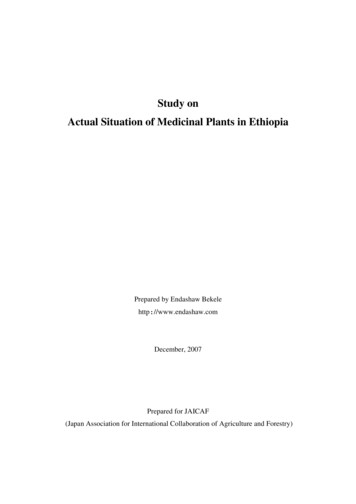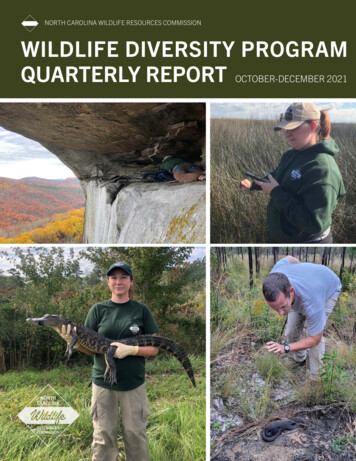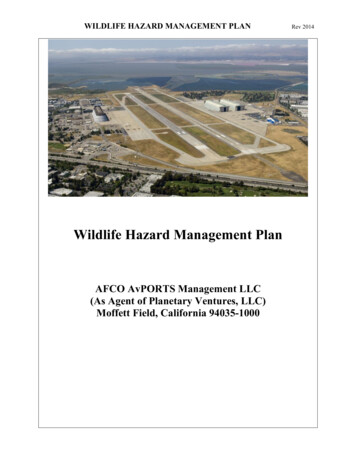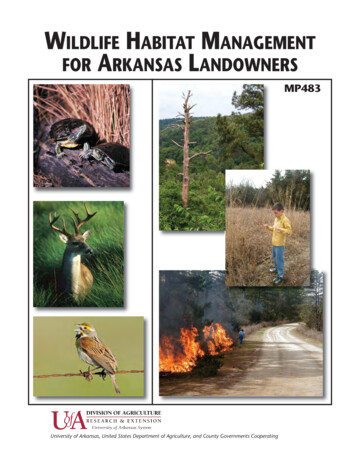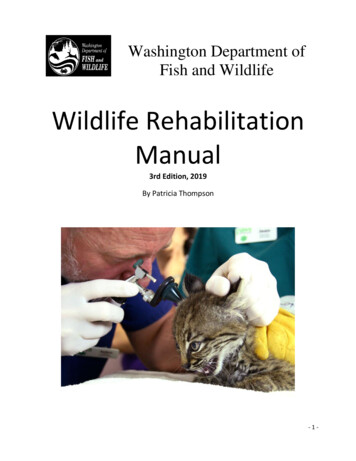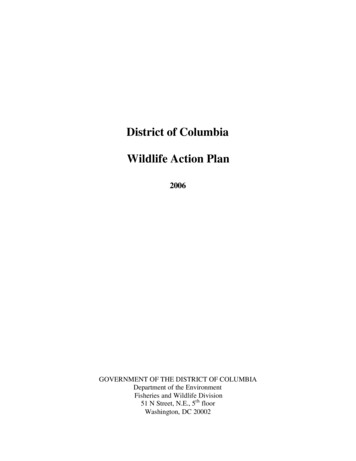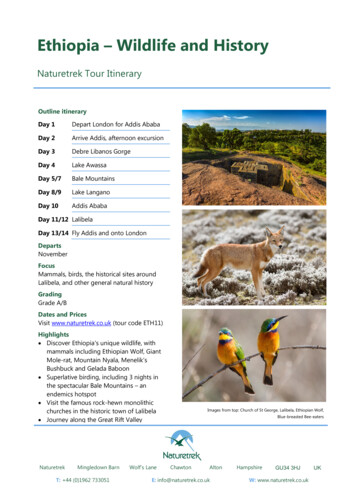
Transcription
Ethiopia – Wildlife and HistoryNaturetrek Tour ItineraryOutline itineraryDay 1Depart London for Addis AbabaDay 2Arrive Addis, afternoon excursionDay 3Debre Libanos GorgeDay 4Lake AwassaDay 5/7Bale MountainsDay 8/9Lake LanganoDay 10Addis AbabaDay 11/12 LalibelaDay 13/14 Fly Addis and onto LondonDepartsNovemberFocusMammals, birds, the historical sites aroundLalibela, and other general natural historyGradingGrade A/BDates and PricesVisit www.naturetrek.co.uk (tour code ETH11)Highlights Discover Ethiopia's unique wildlife, withmammals including Ethiopian Wolf, GiantMole-rat, Mountain Nyala, Menelik’sBushbuck and Gelada Baboon Superlative birding, including 3 nights inthe spectacular Bale Mountains – anendemics hotspot Visit the famous rock-hewn monolithicchurches in the historic town of Lalibela Journey along the Great Rift ValleyNaturetrekMingledown BarnT: 44 (0)1962 733051Wolf’s LaneImages from top: Church of St George, Lalibela, Ethiopian Wolf,Blue-breasted Bee-eatersChawtonAltonE: info@naturetrek.co.ukHampshireGU34 3HJW: www.naturetrek.co.ukUK
Ethiopia – Wildlife & HistoryTour ItineraryIntroductionEthiopia offers an intoxicating blend of magnificent scenery, fascinating wildlife and an exceedingly richculture and history. It was perhaps the earliest home of mankind, and later to Prester John – the legendaryruler of the east – and a dynasty of monarchs originating from the Queen of Sheba. It is a land of mixedreligion, countless tribes and even more languages. Ethiopia is also one of the very few African countries tohave escaped 19th century colonialism, and remains fiercely independent to this day. It is not only thecountry's long and rich history that makes Ethiopia such a special place, however, for its wildlife, too, is bothexciting and unique. From the high moorlands of the Bale Mountains to the soda and freshwater lakes of theGreat Rift Valley, a wonderfully diverserange of habitats is home to over 840species of birds, around 50 of which areregional endemics or near-endemics, and80 species of larger mammals, of which10% are endemic.Our tour begins with a two-night stay inthe capital, Addis Ababa. From here we willtake a day trip to Debre Libanos Gorge insearchofWattledIbis,AbyssinianLongclaw and Blue-winged Goose, plustroops of shaggy Gelada Baboons, all ofBale Mountains National Parkwhich are endemic to Ethiopia. Driving south, we will stop to enjoy the birdlife of Lake Awassa, before arrivingin the Bale Mountains National Park for a three-night stay, including two nights at the beautiful BaleMountain Lodge. Approaching the park, the scenery becomes increasingly spectacular and we will hope tosee the majestic and endemic Mountain Nyala, plus such avian endemics as Black-headed Siskin, AbyssinianCatbird and Rouget’s Rail. As we cross the Afro-alpine habitat of the Senetti Plateau we will search for therare Ethiopian Wolf and its prey, the endearing Giant Mole-rat. Serval, the endemic Bale Monkey and GiantForest Hog are also possible. Returning north through the Great Rift Valley, we will stop to relax for twonights at a comfortable lodge on the shores of Lake Langano where we can enjoy some easy birding and theresident Black-and-White Colobus. Then, for the final section of our tour, we will fly north to Lalibela for atwo-night stay in the medieval capital of Ethiopia, home to the monasteries of Yemrehanna Kristos andAsheton Maryam and the 800-year-old monolithic rock-hewn churches that many consider to be anunofficial eighth wonder of the world!ItineraryPlease note that the itinerary below offers our planned programme of excursions. However, adverse weatherand other local considerations can necessitate some re-ordering of the programme during the course of thetour, though this will always be done to maximise best use of the time and weather conditions available. NaturetrekNovember 191
Tour ItineraryEthiopia’s Endemic MammalsDay 1In FlightWe depart from London Heathrow this evening on an Ethiopian Airlines overnight flight direct to AddisAbaba.Day 2Addis AbabaArriving in Addis this morning, we transfer to a comfortable hotel which will be our base for the next twonights, where we can freshen up after the flight and enjoy breakfast or an early lunch. This afternoon we willexplore a little of the busy capital and pay a visit to the National Museum where the famous early hominid,Lucy – who is feasibly our universal ancestor – is housed.Day 3Debre Libanos Gorge & Soluta PlainsWe will plan an early start this morning for a day's excursion to the Debre Libanos Gorge. Leaving Addis, wedrive up into the eucalyptus-clad Entoto Hills and cross a pass at 8,537 feet to reach the Solulta Plains, aregion of grassy uplands and small pools with a fine complement of birdlife. Wattled and Sacred Ibises, Bluewinged and Egyptian Geese, Yellow-billed Ducks, Pallid Harriers, Black-shouldered Kites, Short-crested andRed-capped Larks, Abyssinian Longclaws, Isabelline and Red-breasted Wheatears, Hill Chats, GroundscraperThrushes, Pied Crows and Cape Rooks are all to be found in the area. Driving on to the Gorge – carved deeplyby a tributary of the Blue Nile – we will first explore the forested escarpment above the monastery of DebreLibanos, stopping to look at this impressive building, and will look for the endemic Ruppell's Chat. We willthen walk along the lip of the gorge (a good spot for a picnic with a spectacular view!) where Lammergeiers,Ruppell's Griffons, Lanner Falcons, Fan-tailed Ravens, Black Kites, and the endemic White-billed Starlingssoar.Our main goal this afternoon is to look for the splendid Gelada Baboon, which is endemic to Ethiopia, andoften seen here in large troops. These magnificent animals are sure to be an early highlight of the tour andwe plan to spend some time watching the social interactions amongst the group. The adult males areespecially impressive with their long flowing manes and red 'bleeding heart'. The troops may cover a rangeof about 3-7 km each day along the borders of the cliffs, where they forage along the edge of the gorgeWattled Ibis (Tim Melling)2Gelada Baboon (Tim Melling) NaturetrekNovember 19
Ethiopia – Wildlife and HistoryTour Itineraryfeeding on grasses, seeds and fruits. At the end of a full and exciting day out, we will return Addis ahead ofour journey south the next morning.Day 4Lake AwassaThis morning we embark on our journey south, driving to the Rift Valley lakes. We will make short stops onthe way at Lakes Koka and Zwai, where we should see numerous waterbirds. Lake Koka offers a great varietyof waders, herons, spoonbills and egrets, patrolled by overhead harriers and vultures, and Ethiopian andWire-tailed Swallows. At Lake Zwai, as well as the huge numbers of waterbirds including pelicans and storks,we can look for the endearing Tree Hyrax which is generally uncommon in central Ethiopia.We stop overnight at Lake Awassa, a beautiful freshwater lake, set amongst hills and luxuriant vegetation,quite unlike the alkaline lakes to the north. We should encounter numerous waterbirds, including Black,Goliath and other herons, Marabou Stork, Hamerkop, Hadada Ibis, a variety of egrets, the dainty AfricanPygmy Goose, Fulvous and White-faced Whistling Duck, Knob-billed Duck, Black Crake, African Jacana, andboth Pied and Malachite Kingfisher. Nearby, in the mature acacia woodland beside the lake, we will look forEastern Black-and-white Colobus Monkey, Vervet Monkey and Menelik’s Bushbuck. We spend tonight at acomfortable hotel adjacent to the lake shore, and surrounded by plentiful birdlife.Day 5Bale MountainsFor those that wish, you leader will be eager to offer an early morning bird walk along the lake shore. Then,after breakfast, we will embark on the scenic drive to the Bale Mountains National Park. Climbing throughforests, fields, little villages and banana groves, we reach open grassy uplands where Blue-winged Goose,Rouget's Rail and Abyssinian Longclaw introduce us to the long list of Ethiopian endemic birds to be foundin the area. Approaching the park, the scenery becomes increasingly spectacular. Magnificent forests clingto the sides of deep valleys and high peaks, rocky outcrops, pinnacles and ridges pierce horizons, andmoorlands, grasslands and peaty pools sit in plainsand hollows.Around the park headquarters at Dinsho we arelikely to see the endemic Mountain Nyala (amagnificent antelope unique to these hills) andWarthog, and Common Duiker, Bohor Reedbuckand Menelik's Bushbuck may all be seen along theforest margins. We will also make a special effort tofind the near-endemic Abyssinian Long-eared Owl,Mountain Nyalawhich can often be seen at a daytime roost sitehere. Then, we will continue to the town of Gobawhere we overnight in a basic hotel, where we are well positioned for tomorrow’s joureny over the splendidSenetti Plateau. NaturetrekFebruary ‘193
Tour ItineraryDay 6Ethiopia’s Endemic MammalsBale Mountain LodgeThe Bale Mountains, lying between 9,500 feet and 14,360 feet, contain the largest tract of high moorland inAfrica. Virtually uninhabited, they are entirely unspoilt and were set aside as a national park in order toprotect the Mountain Nyala which is found nowhere else in the world. They are green and spacious,decorated with rocky peaks and crags, numerous small lakes, extensive heathland, magnificent cloud forestsand bogs, and possess an exceptional beauty and charm which can be likened to that of the ScottishHighlands.Today we will focus our attention on the Senetti Plateau, beginning our journey by climbing up through thefine Hagenia forest, where we will look out for Chestnut-naped Francolin on the road, and Rufous-breastedSparrowhawk and Mountain Buzzard in the air. Then, we will ascend onto an open moorland plateau wherelittle lakes, extensive grasslands and the weird spikes of primeval-looking Giant Lobelias and Red-hot Pokerscreate a wonderful Afro-alpine habitat. Wattled Crane and Montane Francolin are two resident specialities,and amongst an interesting collection of upland birds we are likely to see eleven of Ethiopia's 29 endemics:Blue-winged Goose, Rouget's Rail, Spot-breasted Plover, White-collared Pigeon, Black-winged Lovebird,Golden-backed Woodpecker, Abyssinian Longclaw, Abyssinian Catbird, White-backed Tit, Black-headedSiskin and Thick-billed Raven!One of our main aims for today will be a sighting (or sightings) of the endangered Ethiopian Wolf and itsprey: Grass Rats, Swamp Rats and the bizarre and endemic Giant Mole-Rat. These rodents also attract manybirds of prey, include wintering Spotted, Imperial and other Aquila eagles, as well as almost all of Ethiopia'svulture species. The beautiful Ethiopian Wolf is endemic to Ethiopia and this plateau is its stronghold; theyroam the park in small groups and we will hope to spot one as we drive slowly over the plateau. We shouldalso keep our eyes peeled for Klippspringer,the endemic Stark’s Hare and Rock Hyraxwhich are all common in this area.During the latter part of the day we willcontinue across the plateau and descenddown the magnificent Harenna Escarpment.We will arrive later this afternoon at thebeautiful Bale Mountain Lodge, deep in theHarenna Forest, for a two night stay. BaleMountain Lodge is one of very few boutiquelodges found in Ethiopia, and each of theWalking out from Bale Mountain Lodge (Helen Pinchin)spacious, comfortable guest rooms has awood burning stove and stunning views towards the ridgeline of the plateau.Day 7Bale Mountain LodgeWe have a further full day today to explore the Bale Mountains at our leisure, from our comfortable base atBale Mountain Lodge. There are a number of marked trails that spill out from the vicinity of the lodge, givingus opportunity to search for any of the special birds and mammals we might have missed yesterday. In4 NaturetrekNovember 19
Ethiopia – Wildlife and HistoryTour Itineraryaddition, in the area around the lodge we have a good chance of finding the endemic Bale Monkey, anddriving along the edge of the forest as dusk falls we may be lucky enough to spot a Serval or the rare GiantForest Hog. Tonight, we will enjoy a second night at Bale Mountain Lodge.Day 8Lake LanganoToday we retrace our route, back up the Harenna escaprment and over the Senetti Plateau, with a secondopportunity to try for Ethiopian Wolf should we have been unlucky previously, or indeed if we are keen foranother sighting! Making a few stops as we go, we will slowly make our way to Lake Langano, arriving in thelate afternoon with time to explore a little of our surroundings before dinner. We spend the next two nightsat the delightful Hara Langano Lodge, where the indivdual rooms, or “gojos” as they are known locally, areset in amongst the trees or on the shores of the lake.Day 9Lake LanganoToday we have a full day to relax and enjoy Lake Langano. An early morning walk around the grounds ofHara will yield a kaleidescope of colourful birdlife, including a variety of sunbirds, woodpeckers, Silverycheeked Hornbills, White-browed Robin Chats, Double-toothed Barbets, African Firefinches and a host ofother bird species. Hippos are a frequent sight in the lake’s shallows and there is usually a population ofOlive Baboons and Black and White Colobus Monkeys in residence around the lodge.Later in the day we’ll explore some of the woodland further back from the lake shore. Whilst the lake's watersare deep and sterile, and largely devoid of water birds, this woodland makes fine amends! Dark ChantingGoshawks, African Fish Eagles, Hemprich's and Von der Decken's Hornbills, Cardinal Woodpeckers, White-bellied Go-away Birds, Red-billed and White-headed Buffalo Weavers, Northern White-crowned Shrikes,Blue-naped Mousebirds, Blue-breasted and Little Bee-eaters, White-cheeked Turaco, Mariqua Sunbirds anda variety of colourful finches are all to be found in this dry and thorny habitat.Hara Langano LodgeDay 10White-cheeked Turaco (Daniel Rosengren)Lake LanganoThere is no rush to get underway today, and so we can enjoy a leisurely breakfast and morning birdwalkbefore setting off for Addis Ababa. Heading back north, we will pay a visit to Lake Abiata, which is widelyregarded as Ethiopia's Nakuru. Shallow and saline, it is an enormous lake with huge numbers of birds and NaturetrekFebruary ‘195
Tour ItineraryEthiopia’s Endemic Mammalswe will enjoy this spectacle of colour, looking carefully amongst the flamingos, pelicans, cormorants, storks,herons and waders for any unusual vagrants. We aim to arrive back in Addis Ababa in the late afternoon andovernight at a city hotel.Days 11 – 12LalibelaWe will transfer to the airport early this morningin time to take our flight to Lalibela (which isusually direct, but occasioanlly via Bahir Dar).Lalibela is perched at an altitude of 2,630m, withstunning views of wild craggy peaks and vastrocky escarpments, and is famed for its 13 rock-hewn monolithic churches, built in the early 12thcentury on the order of the Saint and KingLalibela. Set in two clusters either side of the riverthat dissects the town, the churches and chapelswere inscribed as a UNESCO World Heritage SiteChurch of St. George, Lalibelain 1978, and are often cited as the unofficial eighth wonder of the world. Several of the churches are in excessof 10m high, many are meticulously sculpted and decorated, and each is surrounded by trenches andcourtyards and connected through little tunnels and passages to the next. We’ll spend the rest of the daymarvelling at their splendor, then, the following day, we will travel a little further afield to visit two of themost spectacular monasteries, Asheton Mariam and Yemrehanna Kristos.Days 13 – 14Fly Addis and onwards to LondonAfter a final morning in Lalibela, at around lunchtime today we return to the airport to take the flight backto Addis Ababa. We’ll have day rooms booked at a convenient hotel, giving us the opportunity to freshenup, re-pack and enjoy a farewell dinner before returning to the airport for our flight home, which typicallydeparts in the early hours of the morning, arriving into London at around 0630 hours. (NB: occasionally thisflight is scheduled to depart at around 0800 hours in the morning, arriving into London at around 1330hours. If this is the case, we will instead book full overnight rooms in Addis with a transfer back to the airportearly the next morning.)Extra expensesAll food and accommodation is included in the price of this holiday. Please note that we do not include thefollowing in the cost of this holiday: 6Entry visa (currently US 50) – this can be purchased online in advance or on arrival in AddisAll items of a personal nature such as drinks, laundry, souvenirsDiscretionary tips NaturetrekNovember 19
Ethiopia – Wildlife and HistoryTour ItineraryTour gradingWe have graded this tour A/B, with a combinationof walking and wildlife viewing from our vehicle.There are some long road journeys, though thistour is designed to allow a more leisurely pacethan some of our other itineraries! We will often beat altitudes of over 2000m, and sometimes over3000m in the Bale Mountains, but the walking forthe most part of the tour is not difficult, nor doesit ever cover any great distance, and is always takenat a leisurely pace.View from Bale Mountain LodgeAround Lalibela the walking is a little more difficult at times and we have graded this portion of the tour ‘B’.Many of the churches around Lalibela have large, uneven steps, and both monasteries that we intend to visithave a walk of between 400m and 1km of slow ascent, with occasional short but steep sections. The walkingwill be fine for anyone with a reasonable level of fitness, but would be difficult for someone with mobilityissues, or with breathing issues given the high altitude (over 2000m).It is worth stressing that whilst the tourist infrastructure in Ethiopia is improving, accommodation does notcompare with the well-appointed lodges and camps of other East African destinations such as Kenya andTanzania. Although this itinerary uses some of the best available accommodation in the country, it still isn’tunusual to experience problems with electricity and plumbing, or lack of maintenance. You should comeprepared for basic en suite accommodation and a few problems like leaky plumbing, power cuts, lack of hotwater, lights not working, slow service in the restaurant, etc. and hope to be pleasantly surprised. The roadinfrastructure is improving all the time, however, thanks to a massive road building programme funded bythe Chinese, and many (though not all!) roads across the country are now in excellent condition.Entry requirementsUK citizens require a visa to enter Ethiopia. You can apply and pay for an e-Visa in advance of travel byvisiting the Ethiopian e-Visa website: https://www.evisa.gov.et/#/home. The process is fairly quick and easyand saves a little time on arrival in Addis Ababa as you will join a separate e-Visa queue and won’t then needto join a second queue to pay for your visa. You can, however, also obtain and pay for your visa on arrival atAddis Ababa Bole Airport at a cost of US 50 (or the equivalent amount in British pounds, Euros, EthiopianBirr and numerous other major currencies which are all accepted). Citizens of other countries should checkrequirements with their nearest Ethiopian embassy.You should also take malaria prophylactics and some vaccinations are recommended. Details will be sentwith pre-departure information, but you should visit your GP or local travel clinic to discuss your travel plansand ask their advice. NaturetrekFebruary ‘197
Tour ItineraryEthiopia’s Endemic MammalsRegional departuresConnecting flights to and from Heathrow with British Airways (currently from Manchester, Newcastle,Edinburgh, Glasgow, Aberdeen, Belfast, Dublin and Jersey) are available at a cost of around 185 return.Ethiopian Airlines has also introduced a new route from Manchester to Addis Ababa (with a touch down inBrussels), which may well coordinate with the timings for this tour. Please contact the Naturetrek office forfurther information.Your safety & securityYou have chosen to travel to Ethiopia. Risks to your safety and security are an unavoidable aspect of all traveland the best current advice on such risks is provided for you by the Foreign and Commonwealth Office. Inorder to assess and protect against any risks in your chosen destination, it is essential that you refer to theForeign Office website – https://www.gov.uk/foreign-travel-advice regularly prior to travel.WeatherThe rainy season in Ethiopia usually runs from June until early October. Therefore, dry and sunny weathershould be expected during our tours, as they all take place during the dry season. The tours in October andNovember are likely to encounter a greener countryside than those in February and March. Daytimetemperatures range from 20 C to the low 30s C (though sometimes much cooler in the mountains), so theclimate is comfortably warm. Cloud is likely in the afternoons and although the lowlands are usually dry atthis time of year, it can rain in the mountains and be cold at night.How to book your placeIn order to book your place on this holiday, please give us a call on 01962 733051 with a credit or debit card,book online at www.naturetrek.co.uk, or alternatively complete and post the booking form at the back of ourmain Naturetrek brochure, together with a deposit of 20% of the holiday cost plus any room supplements ifrequired. If you do not have a copy of the brochure, please call us on 01962 733051 or request one via ourwebsite. Please stipulate any special requirements, for example extension requests or connecting/regionalflights, at the time of booking.Receive our e-newsletterJoin the Naturetrek e-mailing list and be the first to hear about new tours, additional departures and newdates, tour reports and special offers. Visit www.naturetrek.co.uk to sign up.8 NaturetrekNovember 19
We will plan an early start this morning for a day's excursion to the Debre Libanos Gorge. Leaving Addis, we drive up into the eucalyptus-clad Entoto Hills and cross a pass at 8,537 feet to reach the Solulta Plains, a region of grassy uplands and small pools with a fine complement of birdlife. Wattled and Sacred Ibises, Blue -




